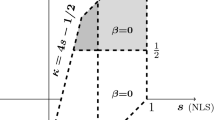Abstract
For the Glimm scheme approximation \({u_\varepsilon}\) to the solution of the system of conservation laws in one space dimension
with initial data u 0 with small total variation, we prove a quadratic (w.r.t. Tot. Var. (u 0)) interaction estimate, which has been used in the literature for stability and convergence results. No assumptions on the structure of the flux f are made (apart from smoothness), and this estimate is the natural extension of the Glimm type interaction estimate for genuinely nonlinear systems.
More precisely, we obtain the following results:
-
a new analysis of the interaction estimates of simple waves;
-
a Lagrangian representation of the derivative of the solution, i.e., a map \({\mathtt{x}(t, w)}\) which follows the trajectory of each wave w from its creation to its cancellation;
-
the introduction of the characteristic interval and partition for couples of waves, representing the common history of the two waves;
-
a new functional \({\mathfrak{Q}}\) controlling the variation in speed of the waves w.r.t. time.
This last functional is the natural extension of the Glimm functional for genuinely nonlinear systems.
The main result is that the distribution \({D_{t} \hat \sigma_k(t,w)}\) is a measure with total mass \({\leq \mathcal{O}(1) {\rm Tot. Var.} (u_0)^2}\) , where \({\hat{\sigma}_k(t, w)}\) is the speed given to the wave w by the Riemann problem at the grid point \({(i\varepsilon, \mathtt{x}(i\varepsilon, w)), t \in [i\varepsilon, (i + 1)\varepsilon)}\).
Similar content being viewed by others
References
Ancona F., Marson A.: Existence theory by front tracking for general nonlinear hyperbolic systems. Arch. Rat. Mech. Anal. 185(2), 287–340 (2007)
Ancona, F., Marson, A.: On the Glimm functional for general hyperbolic systems. Discret. Contin. Dyn. Syst. Supplement, pp. 44–53 (2011)
Ancona F., Marson A.: Sharp convergence rate of the Glimm scheme for general nonlinear hyperbolic systems. Comm. Math. Phys. 302, 581–630 (2011)
Bianchini S.: Interaction estimates and Glimm functional for general hyperbolic systems. Discret. Contin. Dyn. Syst. 9, 133–166 (2003)
Bianchini S., Bressan A.: On a Lyapunov functional relating shortening curves and viscous conservation laws. Nonlinear Anal. Theory, Methods Appl. 51(4), 649–662 (2002)
Bianchini S., Bressan A.: Vanishing viscosity solutions of nonlinear hyperbolic systems. Ann. Math. 161, 223–342 (2005)
Bianchini S., Modena S.: On a quadratic functional for scalar conservation laws. J. Hyperb. Differ. Equ. 11(2), 355–435 (2014)
Bianchini S., Modena S.: Quadratic interaction functional for systems of conservation laws: a case study. Bull. Inst. Math. Acad. Sinica (New Series) 9(3), 487–546 (2014)
Bressan A.: Hyperbolic Systems of Conservation Laws. The One Dimensional Cauchy problem. Oxford University Press, Oxford (2000)
Bressan A., Marson A.: Error Bounds for a Deterministic Version of the Glimm Scheme. Arch. Ration. Mech. Anal. 142, 155–176 (1998)
Dafermos C.: Hyberbolic Conservation Laws in Continuum Physics. Springer, New York (2005)
Glimm J.: Solutions in the large for nonlinear hyperbolic systems of equations. Comm. Pure Appl. Math. 18, 697–715 (1965)
Hua J., Jiang Z., Yang T.: A new Glimm functional and convergence rate of Glimm scheme for general systems of hyperbolic conservation laws. Arch. Rational Mech. Anal. 196, 433–454 (2010)
Hua J., Yang T.: A note on the new Glimm functional for general systems of hyperbolic conservation laws. Math. Models Methods Appl. Sci. 20(5), 815–842 (2010)
Liu, T.-P.: Admissible solutions of hyperbolic conservation laws. Am. Math. Soc. Memoir 240 (1981)
Liu T.-P.: The deterministic version of the Glimm scheme. Comm. Math. Phys. 57, 135–148 (1977)
Temple B.: Systems of conservation laws with invariant submanifolds. Trans. Am. Math. Soc. 280, 781–795 (1983)
Author information
Authors and Affiliations
Corresponding author
Additional information
Communicated by W. Schlag
This work is partially supported by the project PRIN-2012 “Nonlinear Hyperbolic Partial Differential Equations, Dispersive and Transport Equations: theoretical and applicative aspects”.
Part of this paper has been written while the first author was visiting the Department of Mathematics, Penn State University at State College.
Rights and permissions
About this article
Cite this article
Bianchini, S., Modena, S. Quadratic Interaction Functional for General Systems of Conservation Laws. Commun. Math. Phys. 338, 1075–1152 (2015). https://doi.org/10.1007/s00220-015-2372-2
Received:
Accepted:
Published:
Issue Date:
DOI: https://doi.org/10.1007/s00220-015-2372-2



